Dietary Supplementation of Vine Tea Ameliorates Glucose and Lipid Metabolic Disorder via Akt Signaling Pathway in Diabetic Rats
Abstract
1. Introduction
2. Results
2.1. Quality Control of VT
2.2. Effect of VT on Food and Water Intake and Body, Liver and Epididymal White Adipose Tissue Weights in Rats with T2D
2.3. Effect of VT on Serum Biochemical Indices
2.3.1. VT Improves Dyslipidemia and Liver Function
2.3.2. VT Improves Glucose Metabolism Disorder and Insulin Resistance
2.4. Metabolomic Analysis of the Role of VT on the Metabolic Disorder Induced by STZ Combined with HFD in Rats
2.5. VT Affects Purine, Amino Acid and Glucose Metabolism in the T2D Rat Liver
2.6. VT Affects the Expression of Genes Related to Hepatic Glucose Metabolism
2.7. VT Regulates the Liver Expression Level of Proteins Involved in Glucose and Lipid Metabolism
3. Discussion
4. Materials and Methods
4.1. Vine Tea
4.2. Quality Control of VT
4.3. Experimental Animals
4.4. Experimental Design
4.5. GTT and ITT
4.6. Serum Biochemical Experiments
4.7. Hepatic Metabolite Profiling
4.8. QRT-PCR
4.9. WB Analysis
4.10. Statistical Analysis
5. Conclusion
Supplementary Materials
Author Contributions
Funding
Conflicts of Interest
References
- Chatterjee, S.; Khunti, K.; Davies, M.J. Type 2 diabetes. Lancet 2017, 389, 2239–2251. [Google Scholar] [CrossRef]
- Zheng, Y.; Ley, S.H.; Hu, F.B. Global aetiology and epidemiology of type 2 diabetes mellitus and its complications. Nat. Rev. Endocrinol. 2018, 14, 88. [Google Scholar] [CrossRef]
- Reaven, G.M. Role of insulin resistance in human disease (syndrome X): An expanded definition. Annu. Rev. Med. 1993, 44, 121–131. [Google Scholar] [CrossRef]
- Alberti, K.G.M.; Zimmet, P.; Shaw, J. The metabolic syndrome—A new worldwide definition. Lancet 2005, 366, 1059–1062. [Google Scholar] [CrossRef]
- Dandona, P.; Aljada, A.; Chaudhuri, A.; Mohanty, P.; Garg, R. Metabolic syndrome: A comprehensive perspective based on interactions between obesity, diabetes, and inflammation. Circulation 2005, 111, 1448–1454. [Google Scholar] [CrossRef]
- Wilson, P.W.; D’agostino, R.B.; Parise, H.; Sullivan, L.; Meigs, J.B. Metabolic syndrome as a precursor of cardiovascular disease and type 2 diabetes mellitus. Circulation 2005, 112, 3066–3072. [Google Scholar] [CrossRef]
- Oda, E. Metabolic syndrome: Its history, mechanisms, and limitations. Acta Diabetol. 2012, 49, 89–95. [Google Scholar] [CrossRef]
- Nicholson, J.K.; Lindon, J.C.; Holmes, E. ‘Metabonomics’: Understanding the metabolic responses of living systems to pathophysiological stimuli via multivariate statistical analysis of biological NMR spectroscopic data. Xenobiotica 1999, 29, 1181–1189. [Google Scholar] [CrossRef]
- Nicholson, J.K.; Connelly, J.; Lindon, J.C.; Holmes, E. Metabonomics: A platform for studying drug toxicity and gene function. Nat. Rev. Drug Discov. 2002, 1, 153. [Google Scholar] [CrossRef]
- Kuhara, T. Gas chromatographic–mass spectrometric urinary metabolome analysis to study mutations of inborn errors of metabolism. Mass Spectrom. Rev. 2005, 24, 814–827. [Google Scholar] [CrossRef]
- Pan, Z.; Gu, H.; Talaty, N.; Chen, H.; Shanaiah, N.; Hainline, B.E.; Cooks, R.G.; Raftery, D. Principal component analysis of urine metabolites detected by NMR and DESI–MS in patients with inborn errors of metabolism. Anal. Bioanal. Chem. 2007, 387, 539–549. [Google Scholar] [CrossRef]
- Xie, B.; Waters, M.J.; Schirra, H.J. Investigating potential mechanisms of obesity by metabolomics. BioMed Res. Int. 2012, 2012, 805683. [Google Scholar] [CrossRef]
- Bain, J.R.; Stevens, R.D.; Wenner, B.R.; Ilkayeva, O.; Muoio, D.M.; Newgard, C.B. Metabolomics applied to diabetes research: Moving from information to knowledge. Diabetes 2009, 58, 2429–2443. [Google Scholar] [CrossRef]
- Xu, Q.-Y.; Liu, Y.-H.; Zhang, Q.; Ma, B.; Yang, Z.-D.; Liu, L.; Yao, D.; Cui, G.-B.; Sun, J.-J.; Wu, Z.-M. Metabolomic analysis of simvastatin and fenofibrate intervention in high-lipid diet-induced hyperlipidemia rats. Acta Pharmacol. Sin. 2014, 35, 1265. [Google Scholar] [CrossRef]
- Sun, J.-H.; Liu, X.; Cong, L.-X.; Li, H.; Zhang, C.-Y.; Chen, J.-G.; Wang, C.-M. Metabolomics study of the therapeutic mechanism of Schisandra Chinensis lignans in diet-induced hyperlipidemia mice. Lipids Health Dis. 2017, 16, 145. [Google Scholar] [CrossRef]
- Brindle, J.T.; Nicholson, J.K.; Schofield, P.M.; Grainger, D.J.; Holmes, E. Application of chemometrics to 1 H NMR spectroscopic data to investigate a relationship between human serum metabolic profiles and hypertension. Analyst 2003, 128, 32–36. [Google Scholar] [CrossRef]
- Kerru, N.; Singh-Pillay, A.; Awolade, P.; Singh, P. Current anti-diabetic agents and their molecular targets: A review. Eur. J. Med. Chem. 2018, 152, 436–488. [Google Scholar] [CrossRef]
- Bailey, C.J.; Day, C. Traditional plant medicines as treatments for diabetes. Diabetes Care 1989, 12, 553–564. [Google Scholar] [CrossRef]
- Söllner, W.; Steixner, E.; Auer, V.; Schiessling, G.; Stzankay, A.; Iglseder, W.; Lukas, P. Subjective psychological stress and need for psychosocial support in cancer patients during radiotherapy treatment. Strahlenther. Onkol. Organ Dtsch. Rontgenges.... [Et Al] 1998, 174, 408–414. [Google Scholar]
- Yang, C.S.; Landau, J.M. Effects of tea consumption on nutrition and health. J. Nutr. 2000, 130, 2409–2412. [Google Scholar] [CrossRef]
- Auvichayapat, P.; Prapochanung, M.; Tunkamnerdthai, O.; Sripanidkulchai, B.-O.; Auvichayapat, N.; Thinkhamrop, B.; Kunhasura, S.; Wongpratoom, S.; Sinawat, S.; Hongprapas, P. Effectiveness of green tea on weight reduction in obese Thais: A randomized, controlled trial. Physiol. Behav. 2008, 93, 486–491. [Google Scholar] [CrossRef]
- Bogdanski, P.; Suliburska, J.; Szulinska, M.; Stepien, M.; Pupek-Musialik, D.; Jablecka, A. Green tea extract reduces blood pressure, inflammatory biomarkers, and oxidative stress and improves parameters associated with insulin resistance in obese, hypertensive patients. Nutr. Res. 2012, 32, 421–427. [Google Scholar] [CrossRef]
- Yang, C.S.; Zhang, J.; Zhang, L.; Huang, J.; Wang, Y. Mechanisms of body weight reduction and metabolic syndrome alleviation by tea. Mol. Nutr. Food Res. 2016, 60, 160–174. [Google Scholar] [CrossRef] [PubMed]
- Teng, Y.; Li, D.; Guruvaiah, P.; Xu, N.; Xie, Z. Dietary Supplement of Large Yellow Tea Ameliorates Metabolic Syndrome and Attenuates Hepatic Steatosis in db/db Mice. Nutrients 2018, 10, 75. [Google Scholar] [CrossRef]
- Hou, X.; Tong, Q.; Wang, W.; Shi, C.; Xiong, W.; Chen, J.; Liu, X.; Fang, J. Suppression of inflammatory responses by dihydromyricetin, a flavonoid from Ampelopsis grossedentata, via inhibiting the activation of NF-κB and MAPK signaling pathways. J. Nat. Prod. 2015, 78, 1689–1696. [Google Scholar] [CrossRef]
- Zeng, X.; Yang, J.; Hu, O.; Huang, J.; Ran, L.; Chen, M.; Zhang, Y.; Zhou, X.; Zhu, J.; Zhang, Q. Dihydromyricetin ameliorates nonalcoholic fatty liver disease by improving mitochondrial respiratory capacity and redox homeostasis through modulation of SIRT3 signaling. Antioxid. Redox Signal. 2018, 30, 163–183. [Google Scholar] [CrossRef] [PubMed]
- Ye, L.; Wang, H.; Duncan, S.E.; Eigel, W.N.; O’Keefe, S.F. Antioxidant activities of Vine Tea (Ampelopsis grossedentata) extract and its major component dihydromyricetin in soybean oil and cooked ground beef. Food Chem. 2015, 172, 416–422. [Google Scholar] [CrossRef] [PubMed]
- Le, L.; Jiang, B.; Wan, W.; Zhai, W.; Xu, L.; Hu, K.; Xiao, P. Metabolomics reveals the protective of Dihydromyricetin on glucose homeostasis by enhancing insulin sensitivity. Sci. Rep. 2016, 6, 36184. [Google Scholar] [CrossRef]
- Pan, H. Preliminary Study on the Effects of Ampelopsis Grossedentata on Improving Insulin Resistance. Master’s Thesis, Peking Union Medical College, Beijing, China, 2015. (In Chinese). [Google Scholar]
- Wan, W.; Jiang, B.; Sun, L.; Xu, L.; Xiao, P. Metabolomics reveals that vine tea (Ampelopsis grossedentata) prevents high-fat-diet-induced metabolism disorder by improving glucose homeostasis in rats. PLoS ONE 2017, 12, e0182830. [Google Scholar] [CrossRef]
- Du, Q.; Cai, W.; Xia, M.; Ito, Y. Purification of (+)-dihydromyricetin from leaves extract of Ampelopsis grossedentata using high-speed countercurrent chromatograph with scale-up triple columns. J. Chromatogr. A 2002, 973, 217–220. [Google Scholar] [CrossRef]
- Liao, W.; Ning, Z.; Ma, L.; Yin, X.; Wei, Q.; Yuan, E.; Yang, J.; Ren, J. Recrystallization of dihydromyricetin from Ampelopsis grossedentata and its anti-oxidant activity evaluation. Rejuvenation Res. 2014, 17, 422–429. [Google Scholar] [CrossRef] [PubMed]
- Haffner, S.M. Dyslipidemia management in adults with diabetes. Diabetes Care 2004, 27, S68. [Google Scholar] [CrossRef]
- Russo, G.T.; De Cosmo, S.; Viazzi, F.; Pacilli, A.; Ceriello, A.; Genovese, S.; Guida, P.; Giorda, C.; Cucinotta, D.; Pontremoli, R. Plasma triglycerides and HDL-C levels predict the development of diabetic kidney disease in subjects with type 2 diabetes: The AMD annals initiative. Diabetes Care 2016, 39, 2278–2287. [Google Scholar] [CrossRef]
- Rodriguez, V.; Newman, J.D.; Schwartzbard, A.Z. Towards more specific treatment for diabetic dyslipidemia. Curr. Opin. Lipidol. 2018, 29, 307. [Google Scholar] [CrossRef]
- Engelgau, M.M.; Thompson, T.J.; Herman, W.H.; Boyle, J.P.; Aubert, R.E.; Kenny, S.J.; Badran, A.; Sous, E.S.; Ali, M.A. Comparison of fasting and 2-hour glucose and HbA1c levels for diagnosing diabetes: Diagnostic criteria and performance revisited. Diabetes Care 1997, 20, 785–791. [Google Scholar] [CrossRef]
- Rohlfing, C.L.; Wiedmeyer, H.-M.; Little, R.R.; England, J.D.; Tennill, A.; Goldstein, D.E. Defining the relationship between plasma glucose and HbA1c: Analysis of glucose profiles and HbA1c in the Diabetes Control and Complications Trial. Diabetes Care 2002, 25, 275–278. [Google Scholar] [CrossRef]
- Newsholme, P.; Brennan, L.; Blanca, R.; Maechler, P. New insights into amino acid metabolism, β-cell function and diabetes. Clin. Sci. 2005, 108, 185–194. [Google Scholar] [CrossRef]
- Suhre, K. Metabolic profiling in diabetes. J. Endocrinol. 2014, 221, R75–R85. [Google Scholar] [CrossRef]
- Zhou, Y.; Liang, X.; Chang, H.; Shu, F.; Wu, Y.; Zhang, T.; Fu, Y.; Zhang, Q.; Zhu, J.D.; Mi, M. Ampelopsin-induced autophagy protects breast cancer cells from apoptosis through A kt-m TOR pathway via endoplasmic reticulum stress. Cancer Sci. 2014, 105, 1279–1287. [Google Scholar] [CrossRef]
- Srinivasan, K.; Viswanad, B.; Asrat, L.; Kaul, C.; Ramarao, P. Combination of high-fat diet-fed and low-dose streptozotocin-treated rat: A model for type 2 diabetes and pharmacological screening. Pharmacol. Res. 2005, 52, 313–320. [Google Scholar] [CrossRef]
- Goyal, B.R.; Parmar, K.; Goyal, R.K.; Mehta, A.A. Beneficial role of telmisartan on cardiovascular complications associated with STZ-induced type 2 diabetes in rats. Pharmacol. Rep. 2011, 63, 956–966. [Google Scholar] [CrossRef]
- Kleinert, M.; Clemmensen, C.; Hofmann, S.M.; Moore, M.C.; Renner, S.; Woods, S.C.; Huypens, P.; Beckers, J.; De Angelis, M.H.; Schürmann, A. Animal models of obesity and diabetes mellitus. Nat. Rev. Endocrinol. 2018, 14, 140. [Google Scholar] [CrossRef]
- Zhao, J.; Cai, C.-K.; Xie, M.; Liu, J.-N.; Wang, B.-Z. Investigation of the therapy targets of Yi-Qi-Yang-Yin-Hua-Tan-Qu-Yu recipe on type 2 diabetes by serum proteome labeled with iTRAQ. J. Ethnopharmacol. 2018, 224, 1–14. [Google Scholar] [CrossRef] [PubMed]
- Skovsø, S.; Damgaard, J.; Fels, J.; Olsen, G.; Wolf, X.; Rolin, B.; Holst, J. Effects of insulin therapy on weight gain and fat distribution in the HF/HS-STZ rat model of type 2 diabetes. Int. J. Obes. 2015, 39, 1531. [Google Scholar] [CrossRef] [PubMed]
- Miller, M.G.; Teates, J.F. The role of taste in dietary self-selection in rats. Behav. Neurosci. 1986, 100, 399. [Google Scholar] [CrossRef]
- Rader, D.J. Effect of insulin resistance, dyslipidemia, and intra-abdominal adiposity on the development of cardiovascular disease and diabetes mellitus. Am. J. Med. 2007, 120, S12–S18. [Google Scholar] [CrossRef]
- Zak, A.; Zeman, M.; Tvrzicka, E.; Stípek, S.; Buchtíková, M.; Pousek, L.; Nováková, E. Fatty acid composition and parameters of VLDL and LDL in persons with dyslipidemia. Cas. Lek. Ceskych 2000, 139, 18–23. [Google Scholar]
- Teramoto, T.; Sasaki, J.; Ishibashi, S.; Birou, S.; Daida, H.; Dohi, S.; Egusa, G.; Hiro, T.; Hirobe, K.; Iida, M. Diagnostic criteria for dyslipidemia. J. Atheroscler. Thromb. 2013, 20, 655–660. [Google Scholar] [CrossRef]
- Liu, T.T.; Zeng, Y.; Tang, K.; Chen, X.; Zhang, W.; Le Xu, X. Dihydromyricetin ameliorates atherosclerosis in LDL receptor deficient mice. Atherosclerosis 2017, 262, 39–50. [Google Scholar] [CrossRef]
- Utzschneider, K.M.; Prigeon, R.L.; Carr, D.B.; Hull, R.L.; Tong, J.; Shofer, J.B.; Retzlaff, B.M.; Knopp, R.H.; Kahn, S.E. Impact of differences in fasting glucose and glucose tolerance on the hyperbolic relationship between insulin sensitivity and insulin responses. Diabetes Care 2006, 29, 356–362. [Google Scholar] [CrossRef]
- Kruger, D.F.; Boucher, J.L.; Banerji, M.A. Utilizing current diagnostic criteria and treatment algorithms for managing type 2 diabetes mellitus. Postgrad. Med. 2011, 123, 54–62. [Google Scholar] [CrossRef] [PubMed]
- Liu, L.; Wan, J.; Lang, H.; Si, M.; Zhu, J.; Zhou, Y.; Mi, M. Dihydromyricetin delays the onset of hyperglycemia and ameliorates insulin resistance without excessive weight gain in Zucker diabetic fatty rats. Mol. Cell. Endocrinol. 2017, 439, 105–115. [Google Scholar] [CrossRef] [PubMed]
- Swami, S.; Sztalryd, C.; Kraemer, F.B. Effects of streptozotocin-induced diabetes on low density lipoprotein receptor expression in rat adipose tissue. J. Lipid Res. 1996, 37, 229–236. [Google Scholar]
- Chen, S.; Zhao, X.; Wan, J.; Ran, L.; Qin, Y.; Wang, X.; Gao, Y.; Shu, F.; Zhang, Y.; Liu, P. Dihydromyricetin improves glucose and lipid metabolism and exerts anti-inflammatory effects in nonalcoholic fatty liver disease: A randomized controlled trial. Pharmacol. Res. 2015, 99, 74–81. [Google Scholar] [CrossRef] [PubMed]
- Liu, C.-E.; Wang, H.-Y.; Wang, Y.-D.; Zhang, J. Study on Ampelsis grossedentata to Lower Plasma Lipids Level. Food Sci. 2005, 26, 237–240. [Google Scholar]
- Ran, L.; Wang, X.; Lang, H.; Xu, J.; Wang, J.; Liu, H.; Mi, M.; Qin, Y. Ampelopsis grossedentata supplementation effectively ameliorates the glycemic control in patients with type 2 diabetes mellitus. Eur. J. Clin. Nutr. 2019, 73, 776–782. [Google Scholar] [CrossRef]
- Arakaki, A.K.; Skolnick, J.; McDonald, J.F. Marker metabolites can be therapeutic targets as well. Nature 2008, 456, 443. [Google Scholar] [CrossRef] [PubMed]
- Adeva-Andany, M.M.; Pérez-Felpete, N.; Fernández-Fernández, C.; Donapetry-García, C.; Pazos-García, C. Liver glucose metabolism in humans. Biosci. Rep. 2016, 36, e00416. [Google Scholar] [CrossRef] [PubMed]
- Lê Cao, K.-A.; Boitard, S.; Besse, P. Sparse PLS discriminant analysis: Biologically relevant feature selection and graphical displays for multiclass problems. BMC Bioinform. 2011, 12, 253. [Google Scholar] [CrossRef]
- Taylor, L.; Wilson, A.; Teare, M. AB0019 A PLS multivariate model to predict RA radiological severity by selecting key predictors from a large panel of SNPS and environmental factors. Ann. Rheum. Dis. 2013, 71, 638. [Google Scholar] [CrossRef]
- Jiang, M.; Wang, C.; Zhang, Y.; Feng, Y.; Wang, Y.; Zhu, Y. Sparse Partial-least-squares Discriminant Analysis for Different Geographical Origins of Salvia miltiorrhiza by 1H-NMR-based Metabolomics. Phytochem. Anal. 2014, 25, 50–58. [Google Scholar] [CrossRef]
- Gaydou, V.D.; Polette, M.; Gobinet, C.; Kileztky, C.; Manfait, M.; Birembaut, P.; Piot, O. Infrared spectral diagnosis for predictive cancer medicine: Application to the early diagnosis and prognosis of preinvasive bronchial intraepithelial lesions. Mol. Cell. Biol. 2015. [Google Scholar] [CrossRef]
- Szymańska, E.; Brodrick, E.; Williams, M.; Davies, A.N.; van Manen, H.-J.; Buydens, L.M. Data size reduction strategy for the classification of breath and air samples using multicapillary column-ion mobility spectrometry. Anal. Chem. 2015, 87, 869–875. [Google Scholar] [CrossRef]
- Lee, L.-C.; Liong, C.-Y.; Osman, K.; Jemain, A.A. In Forensic differentiation of paper by ATR-FTIR spectroscopy technique and partial least-squares-discriminant analysis (PLS-DA). AIP Conf. Proc. 2016, 1750, 060016. [Google Scholar]
- Trainor, P.J.; DeFilippis, A.P.; Rai, S.N. Evaluation of classifier performance for multiclass phenotype discrimination in untargeted metabolomics. Metabolites 2017, 7, 30. [Google Scholar] [CrossRef]
- Wang, T.J.; Larson, M.G.; Vasan, R.S.; Cheng, S.; Rhee, E.P.; McCabe, E.; Lewis, G.D.; Fox, C.S.; Jacques, P.F.; Fernandez, C. Metabolite profiles and the risk of developing diabetes. Nat. Med. 2011, 17, 448. [Google Scholar] [CrossRef]
- Xia, J.; Wang, Z.; Zhang, F. Association between related purine metabolites and diabetic retinopathy in type 2 diabetic patients. Int. J. Endocrinol. 2014, 2014, 651050. [Google Scholar] [CrossRef]
- Schwenk, W.F.; Haymond, M.W. Decreased uptake of glucose by human forearm during infusion of leucine, isoleucine, or threonine. Diabetes 1987, 36, 199–204. [Google Scholar] [CrossRef]
- Guasch-Ferré, M.; Hruby, A.; Toledo, E.; Clish, C.B.; Martínez-González, M.A.; Salas-Salvadó, J.; Hu, F.B. Metabolomics in prediabetes and diabetes: A systematic review and meta-analysis. Diabetes Care 2016, 39, 833–846. [Google Scholar] [CrossRef]
- Zhao, X.; Han, Q.; Liu, Y.; Sun, C.; Gang, X.; Wang, G. The relationship between branched-chain amino acid related metabolomic signature and insulin resistance: A systematic review. J. Diabetes Res. 2016, 2016, 2794591. [Google Scholar] [CrossRef]
- Cheng, S.; Rhee, E.P.; Larson, M.G.; Lewis, G.D.; McCabe, E.L.; Shen, D.; Palma, M.J.; Roberts, L.D.; Dejam, A.; Souza, A.L. Metabolite profiling identifies pathways associated with metabolic risk in humans. Circulation 2012, 125, 2222–2231. [Google Scholar] [CrossRef]
- Krebs, M.; Krssak, M.; Bernroider, E.; Anderwald, C.; Brehm, A.; Meyerspeer, M.; Nowotny, P.; Roth, E.; Waldhäusl, W.; Roden, M. Mechanism of amino acid-induced skeletal muscle insulin resistance in humans. Diabetes 2002, 51, 599–605. [Google Scholar] [CrossRef]
- Szabo, A.; Kenesei, E.; Körner, A.; Miltenyi, M.; Szücs, L.; Nagy, I. Changes in plasma and urinary amino acid levels during diabetic ketoacidosis in children. Diabetes Res. Clin. Pract. 1991, 12, 91–97. [Google Scholar] [CrossRef]
- Huffman, K.M.; Slentz, C.A.; Bateman, L.A.; Thompson, D.; Muehlbauer, M.J.; Bain, J.R.; Stevens, R.D.; Wenner, B.R.; Kraus, V.B.; Newgard, C.B. Exercise-induced changes in metabolic intermediates, hormones, and inflammatory markers associated with improvements in insulin sensitivity. Diabetes Care 2011, 34, 174–176. [Google Scholar] [CrossRef]
- Seegmiller, J.E. Purine metabolism. Arthritis Rheum. 1975, 18, 681–686. [Google Scholar] [CrossRef]
- Fox, I.H. Metabolic basis for disorders of purine nucleotide degradation. Metabolism 1981, 30, 616–634. [Google Scholar] [CrossRef]
- Davies, O.; Mendes, P.; Smallbone, K.; Malys, N. Characterisation of multiple substrate-specific (d) ITP/(d) XTPase and modelling of deaminated purine nucleotide metabolism. BMB Rep. 2012, 45, 259–264. [Google Scholar] [CrossRef]
- Dudzinska, W. Uridine correlates with the concentration of fructosamine and HbA1c in children with type 1 diabetes. Acta Paediatr. 2011, 100, 712–716. [Google Scholar] [CrossRef] [PubMed]
- Xiang, L.; Zhang, H.; Wei, J.; Tian, X.Y.; Luan, H.; Li, S.; Zhao, H.; Cao, G.; Chung, A.C.; Yang, C. Metabolomics studies on db/db diabetic mice in skeletal muscle reveal effective clearance of overloaded intermediates by exercise. Anal. Chim. Acta 2018, 1037, 130–139. [Google Scholar] [CrossRef]
- Diraison, F.; Parton, L.; Ferré, P.; Foufelle, F.; Briscoe, C.P.; Leclerc, I.; Rutter, G.A. Over-expression of sterol-regulatory-element-binding protein-1c (SREBP1c) in rat pancreatic islets induces lipogenesis and decreases glucose-stimulated insulin release: Modulation by 5-aminoimidazole-4-carboxamide ribonucleoside (AICAR). Biochem. J. 2004, 378, 769–778. [Google Scholar] [CrossRef]
- Winder, W.A.; Hardie, D. AMP-activated protein kinase, a metabolic master switch: Possible roles in type 2 diabetes. Am. J. Physiol. -Endocrinol. Metab. 1999, 277, E1–E10. [Google Scholar]
- Zhang, B.B.; Zhou, G.; Li, C. AMPK: An emerging drug target for diabetes and the metabolic syndrome. Cell Metab. 2009, 9, 407–416. [Google Scholar] [CrossRef] [PubMed]
- Iglesias, M.A.; Furler, S.M.; Cooney, G.J.; Kraegen, E.W.; Ye, J.-M. AMP-Activated Protein Kinase Activation by AICAR Increases Both Muscle Fatty Acid and Glucose Uptake in White Muscle of Insulin-Resistant Rats In Vivo. Diabetes 2004, 53, 1649–1654. [Google Scholar] [CrossRef]
- Bergeron, R.; Previs, S.F.; Cline, G.W.; Perret, P.; Russell, R.R., III; Young, L.H.; Shulman, G.I. Effect of 5-aminoimidazole-4-carboxamide-1-β-d-ribofuranoside infusion on in vivo glucose and lipid metabolism in lean and obese Zucker rats. Diabetes 2001, 50, 1076–1082. [Google Scholar] [CrossRef]
- Tegos, C.; Beutler, E. Red cell glycolytic intermediates in diabetic patients. J. Lab. Clin. Med. 1980, 96, 85–89. [Google Scholar]
- Chen, L.; Cheng, C.-Y.; Choi, H.; Ikram, M.K.; Sabanayagam, C.; Tan, G.S.; Tian, D.; Zhang, L.; Venkatesan, G.; Tai, E.S. Plasma metabonomic profiling of diabetic retinopathy. Diabetes 2016, db150661. [Google Scholar] [CrossRef]
- Garofalo, R.S.; Orena, S.J.; Rafidi, K.; Torchia, A.J.; Stock, J.L.; Hildebrandt, A.L.; Coskran, T.; Black, S.C.; Brees, D.J.; Wicks, J.R.; et al. Severe diabetes, age-dependent loss of adipose tissue, and mild growth deficiency in mice lacking Akt2/PKB beta. J. Clin. Investig. 2003, 112, 197–208. [Google Scholar] [CrossRef]
- Nakae, J.; Kitamura, T.; Kitamura, Y.; Biggs, W.H., III; Arden, K.C.; Accili, D. The forkhead transcription factor Foxo1 regulates adipocyte differentiation. Dev. Cell 2003, 4, 119–129. [Google Scholar] [CrossRef]
- Gómez-Valadés, A.G.; Méndez-Lucas, A.; Vidal-Alabró, A.; Blasco, F.X.; Chillon, M.; Bartrons, R.; Bermúdez, J.; Perales, J.C. Pck1 gene silencing in the liver improves glycemia control, insulin sensitivity, and dyslipidemia in db/db mice. Diabetes 2008, 57, 2199–2210. [Google Scholar] [CrossRef]
- Collins, Q.F.; Xiong, Y.; Lupo, E.G.; Liu, H.Y.; Cao, W. p38 Mitogen-activated protein kinase mediates free fatty acid-induced gluconeogenesis in hepatocytes. J. Biol. Chem. 2006, 281, 24336–24344. [Google Scholar] [CrossRef]
- Huang, Z.; Xu, X.; Lu, F.; Wang, N.; Chen, G.; Zhao, Y.; Zou, X.; Wang, K.; Dong, H.; Xu, L. Jiao tai wan attenuates hepatic lipid accumulation in type 2 diabetes mellitus. Evid.-Based Complement. Altern. Med. 2013, 2013, 567045. [Google Scholar]
- Devarshi, P.P.; Jangale, N.M.; Ghule, A.E.; Bodhankar, S.L.; Harsulkar, A.M. Beneficial effects of flaxseed oil and fish oil diet are through modulation of different hepatic genes involved in lipid metabolism in streptozotocin-nicotinamide induced diabetic rats. Genes Nutr. 2013, 8, 329–342. [Google Scholar]
- Hardikar, A.A.; Satoor, S.N.; Karandikar, M.S.; Joglekar, M.V.; Puranik, A.S.; Wong, W.; Kumar, S.; Limaye, A.; Bhat, D.S.; Januszewski, A.S. Multigenerational undernutrition increases susceptibility to obesity and diabetes that is not reversed after dietary recuperation. Cell Metab. 2015, 22, 312–319. [Google Scholar] [CrossRef]
- Yang, H.J.; Lim, J.H.; Park, K.J.; Kang, S.; Kim, D.S.; Park, S. Methyl jasmolate treated buckwheat sprout powder enhances glucose metabolism by potentiating hepatic insulin signaling in estrogen-deficient rats. Nutrition 2016, 32, 129–137. [Google Scholar] [CrossRef]
- Cutfield, W.S.; Jefferies, C.A.; Jackson, W.E.; Robinson, E.M.; Hofman, P.L. Evaluation of HOMA and QUICKI as measures of insulin sensitivity in prepubertal children. Pediatr. Diabetes 2003, 4, 119–125. [Google Scholar] [CrossRef] [PubMed]
- Jiang, B.; Le, L.; Wan, W.; Zhai, W.; Hu, K.; Xu, L.; Xiao, P. The flower tea Coreopsis tinctoria increases insulin sensitivity and regulates hepatic metabolism in rats fed a high-fat diet. Endocrinology 2015, 156, 2006–2018. [Google Scholar] [CrossRef] [PubMed]
- Wan, W.; Li, H.; Xiang, J.; Yi, F.; Xu, L.; Jiang, B.; Xiao, P. Aqueous Extract of Black Maca Prevents Metabolism Disorder via Regulating the Glycolysis/Gluconeogenesis-TCA Cycle and PPARα Signaling Activation in Golden Hamsters Fed a High-Fat, High-Fructose Diet. Front. Pharmacol. 2018, 9, 333. [Google Scholar] [CrossRef] [PubMed]
Sample Availability: Samples of the VT and DHM are available from the authors. |
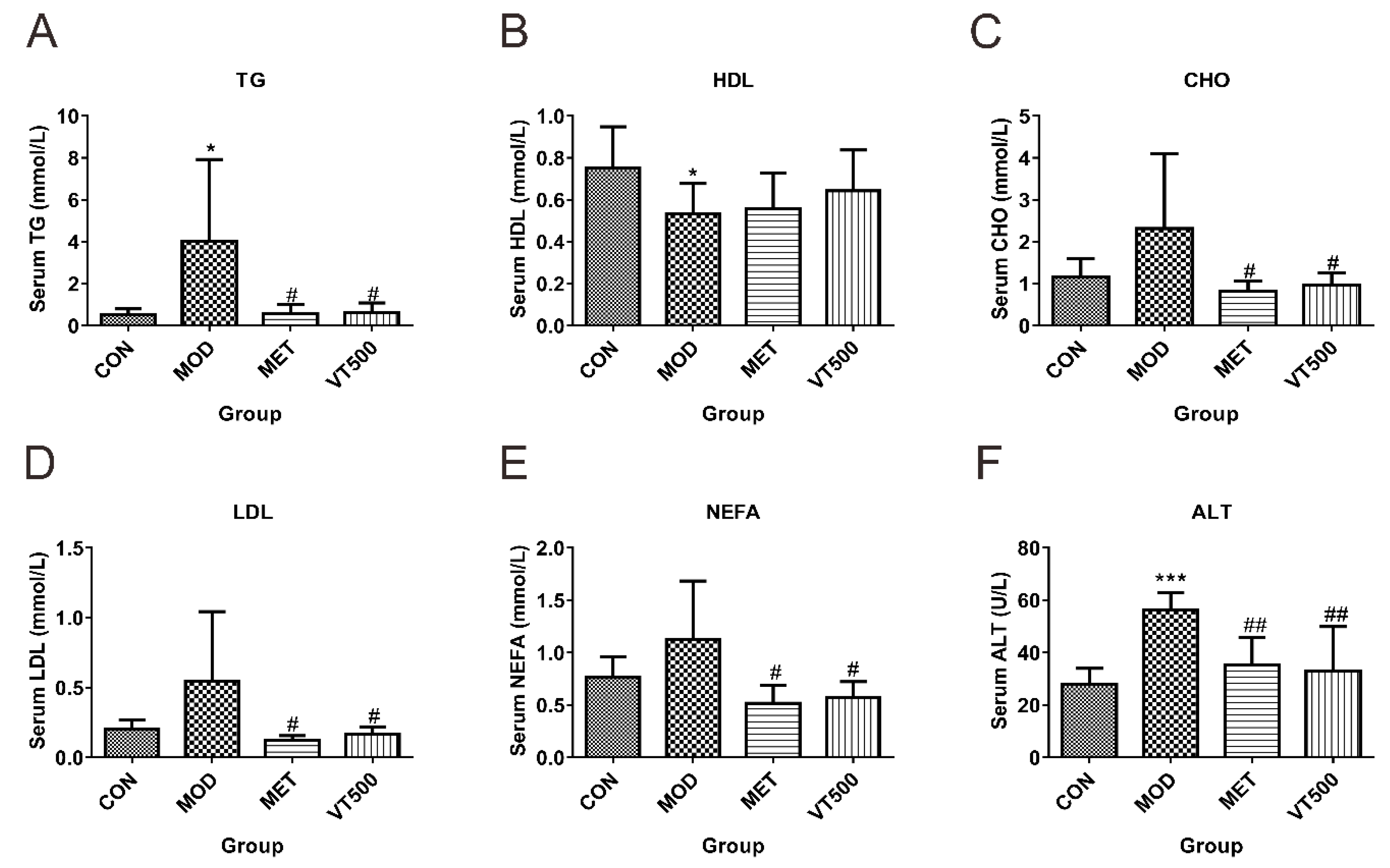
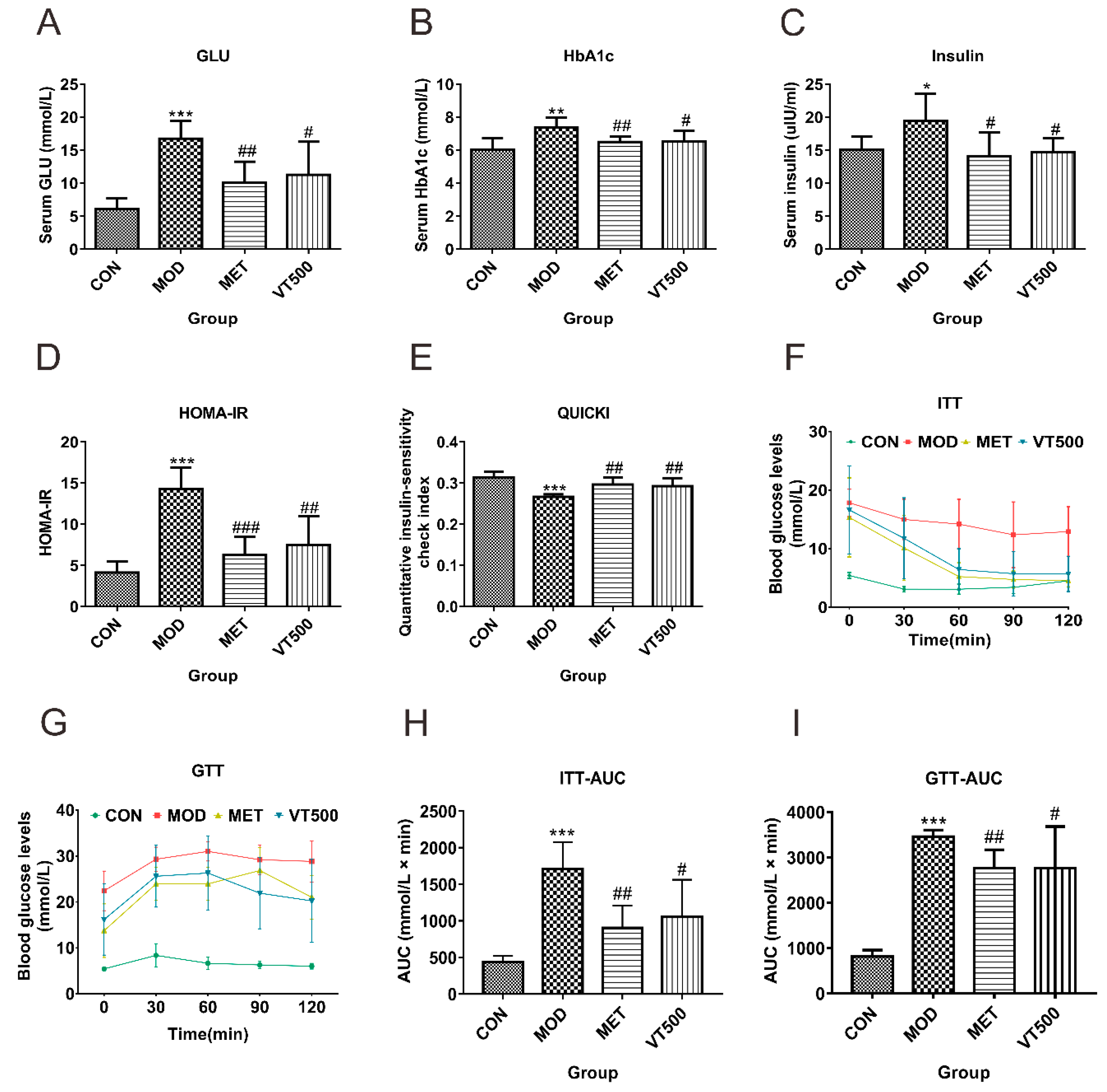
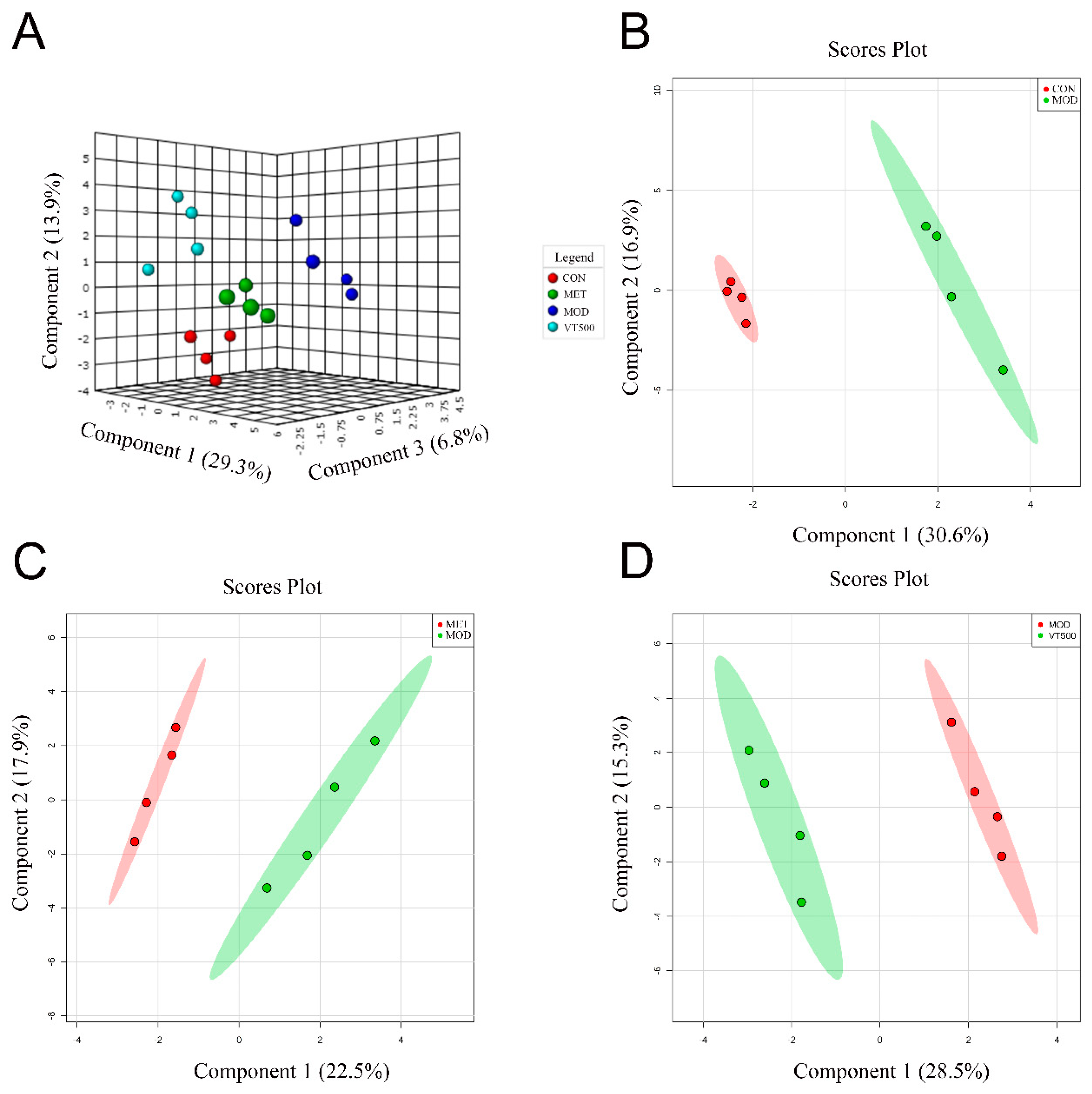

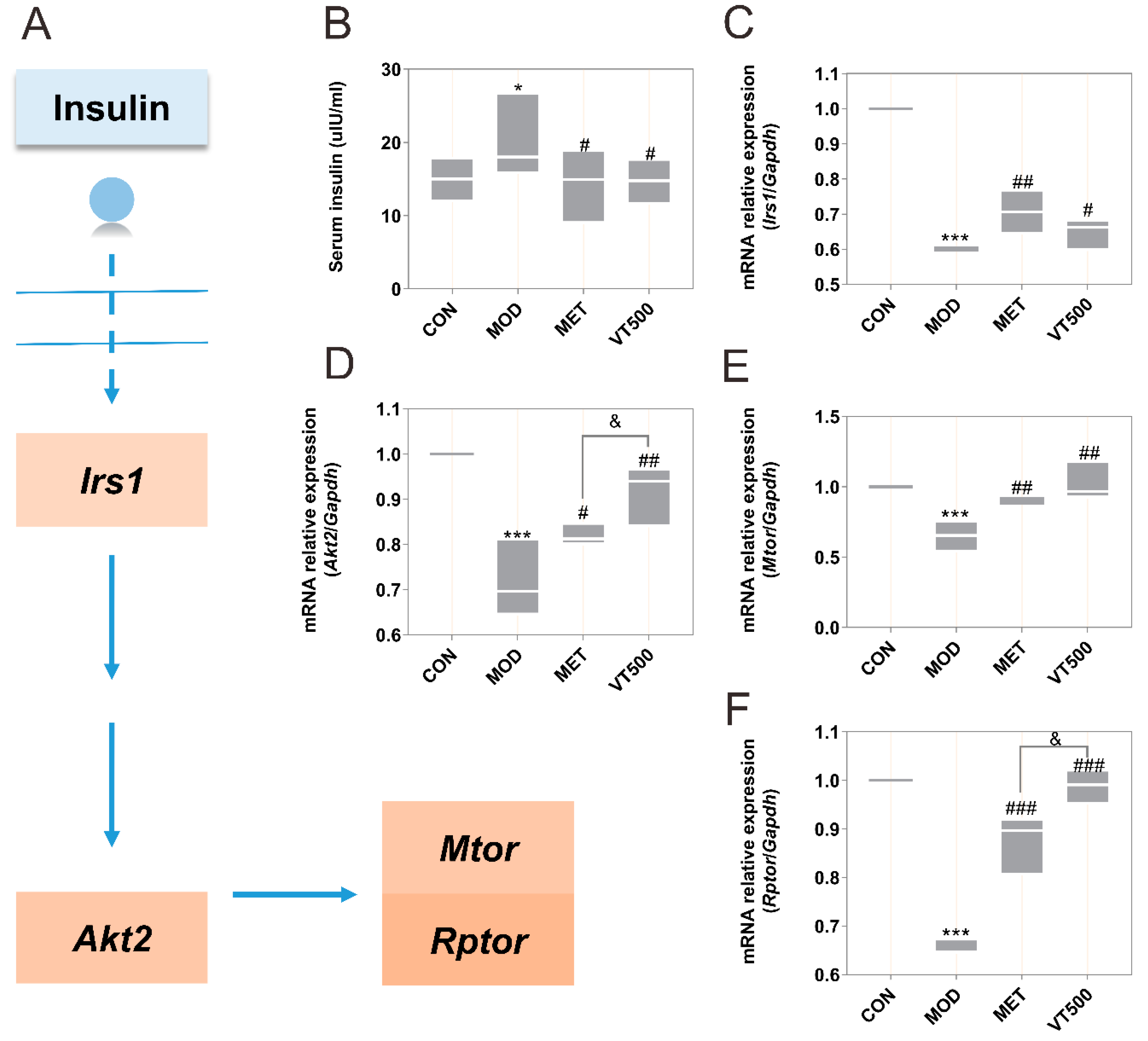
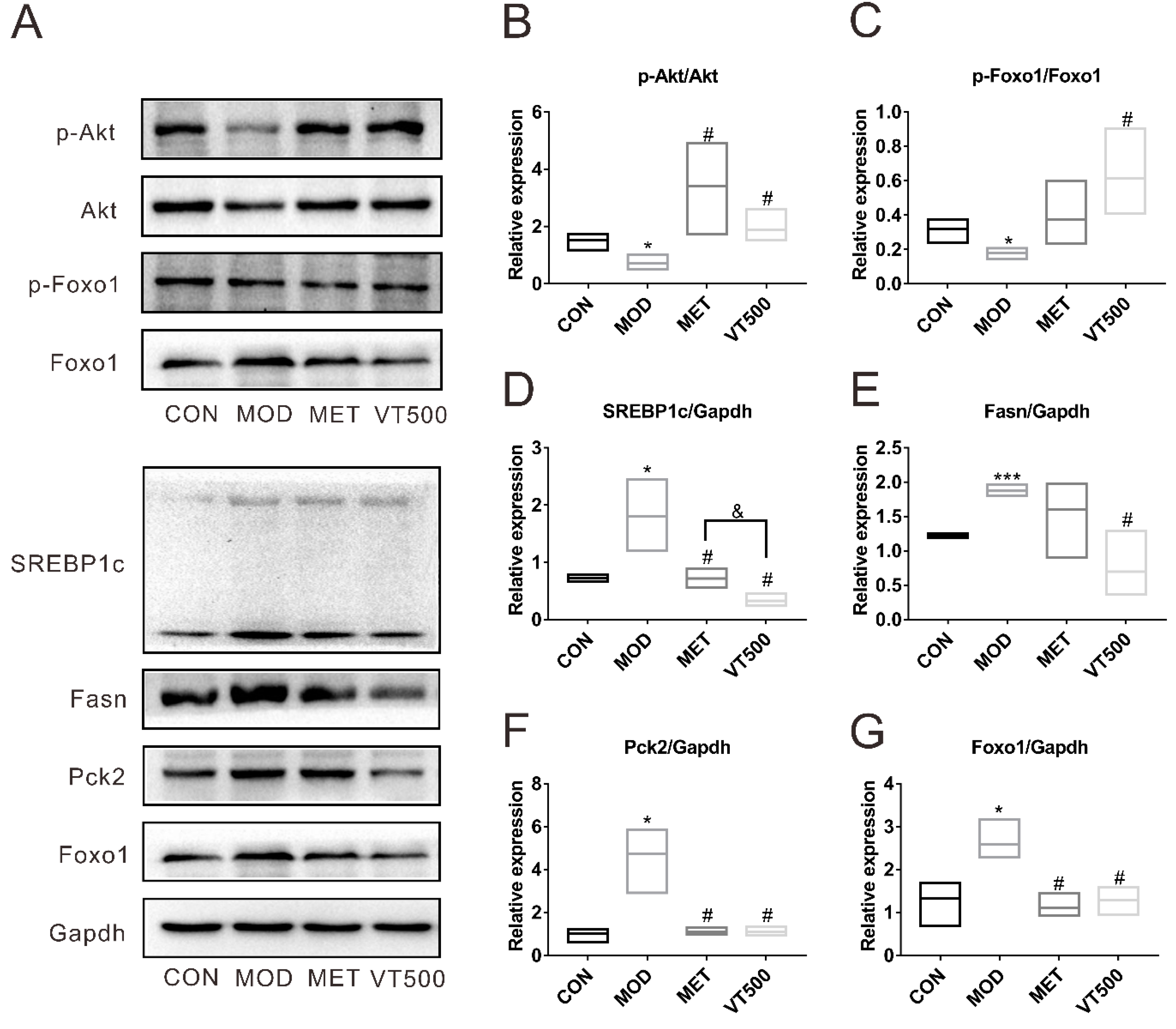
| Group | Initial BW (g) | Initial BW before Drug (VT) Treatment (g) | Final BW (g) | BW Gain (g) | FI Per Day (g) | Food Utilization Rate (%) |
|---|---|---|---|---|---|---|
| CON | 250.1 ± 15.2 | 549.5 ± 92.1 | 607.7 ± 75.4 | 58.2 ± 23.4 | 25.9 ± 3.4 | 7.2 ± 2.9 |
| MOD | 247.2 ± 15.1 | 429.8 ± 63.1 * | 437.0 ± 52.0 ** | 7.2 ± 17.3 ** | 26.6 ± 7.0 | 0.9 ± 2.1 ** |
| MET | 247.2 ± 15.1 | 451.0 ± 49.1 | 491.2 ± 53.8 | 40.2 ± 26.3 # | 25.1 ± 6.4 | 5.2 ± 3.4 # |
| VT500 | 247.2 ± 15.1 | 443.8 ± 52.5 | 478.5 ± 73.5 | 34.7 ± 24.2 # | 25.5 ± 5.0 | 4.4 ± 3.1 # |
| Time (min) | 0.1% Formic Acid Solution in Water (%) | Methanol (%) |
|---|---|---|
| 0 | 75 | 25 |
| 17 | 40 | 60 |
| 19 | 0 | 100 |
| 22.2 | 75 | 25 |
| Gene | Primers | 5′ Primer Sequence 3′ |
|---|---|---|
| Irs1 | Forward | CAT GAG CCC CAA GAG TGT ATC |
| Reverse | CCA ATG TCA GGA GAG CAA CTA C | |
| Akt2 | Forward | CCG AGT CCT ACA GAA TAC CAG |
| Reverse | ACT CCA TCA CAA AGC ACA GG | |
| Mtor | Forward | ATC CTT AAT CTG TTG CCC CG |
| Reverse | ATG GTG TCT TGC AGG TAC TG | |
| Rptor | Forward | TGG TGC CTG GAG TCA CAC TG |
| Reverse | GCA CAT TCC AGG CGA TGG TG | |
| Gapdh | Forward | GAC ATG CCG CCT GGA GAA AC |
| Reverse | AGC CCA GGA TGC CCT TTA GT |
© 2019 by the authors. Licensee MDPI, Basel, Switzerland. This article is an open access article distributed under the terms and conditions of the Creative Commons Attribution (CC BY) license (http://creativecommons.org/licenses/by/4.0/).
Share and Cite
Xiang, J.; Lv, Q.; Yi, F.; Song, Y.; Le, L.; Jiang, B.; Xu, L.; Xiao, P. Dietary Supplementation of Vine Tea Ameliorates Glucose and Lipid Metabolic Disorder via Akt Signaling Pathway in Diabetic Rats. Molecules 2019, 24, 1866. https://doi.org/10.3390/molecules24101866
Xiang J, Lv Q, Yi F, Song Y, Le L, Jiang B, Xu L, Xiao P. Dietary Supplementation of Vine Tea Ameliorates Glucose and Lipid Metabolic Disorder via Akt Signaling Pathway in Diabetic Rats. Molecules. 2019; 24(10):1866. https://doi.org/10.3390/molecules24101866
Chicago/Turabian StyleXiang, Jiamei, Qiuyue Lv, Fan Yi, Yanjun Song, Liang Le, Baoping Jiang, Lijia Xu, and Peigen Xiao. 2019. "Dietary Supplementation of Vine Tea Ameliorates Glucose and Lipid Metabolic Disorder via Akt Signaling Pathway in Diabetic Rats" Molecules 24, no. 10: 1866. https://doi.org/10.3390/molecules24101866
APA StyleXiang, J., Lv, Q., Yi, F., Song, Y., Le, L., Jiang, B., Xu, L., & Xiao, P. (2019). Dietary Supplementation of Vine Tea Ameliorates Glucose and Lipid Metabolic Disorder via Akt Signaling Pathway in Diabetic Rats. Molecules, 24(10), 1866. https://doi.org/10.3390/molecules24101866






